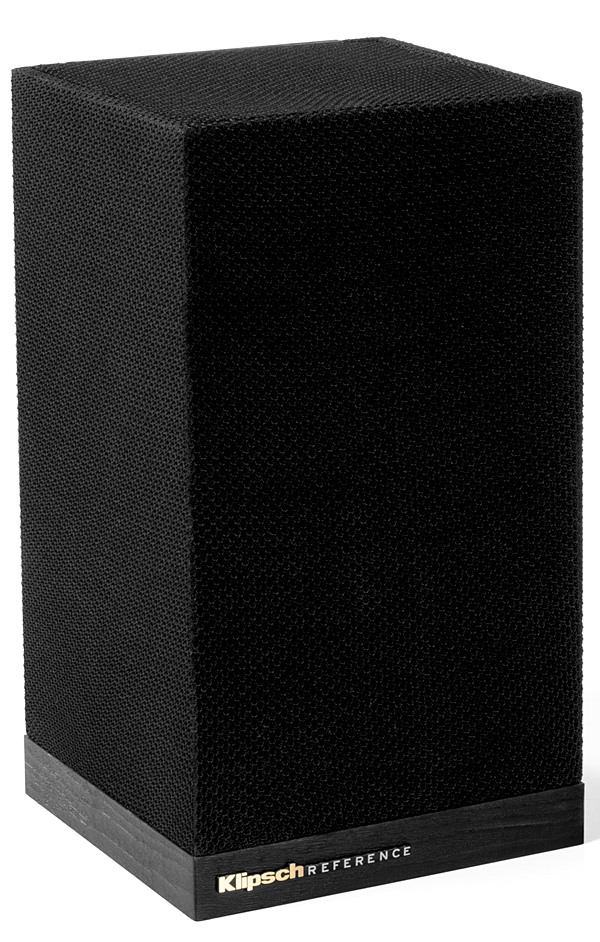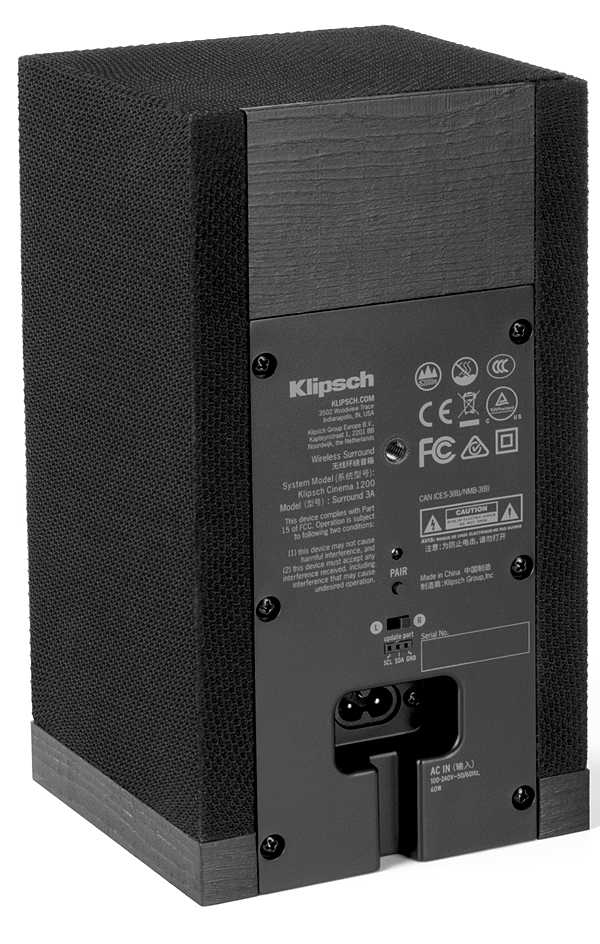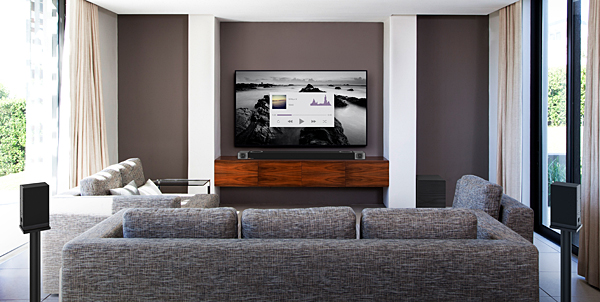Klipsch Cinema 1200 Soundbar System Review Page 2
 Once everything is powered up, the bar automatically connects wirelessly to the sub and surrounds, or you can use buttons on the devices to re-pair them. From there, the Klipsch Connect app lets you link the system with your home network and Alexa. (You use the Google Home app to set up Google Assistant.) There's no microphone on the remote to communicate voice commands, so you'll need your phone or an Alexa- or Google-enabled speaker to use that feature.
Once everything is powered up, the bar automatically connects wirelessly to the sub and surrounds, or you can use buttons on the devices to re-pair them. From there, the Klipsch Connect app lets you link the system with your home network and Alexa. (You use the Google Home app to set up Google Assistant.) There's no microphone on the remote to communicate voice commands, so you'll need your phone or an Alexa- or Google-enabled speaker to use that feature.
Performance
I began auditions with music from CDs and my Tidal Hi-Fi account. There are six sound modes you can cycle through with the remote's Mode button: Standard, Direct, Movie, Music, Game, and Party. The Party mode delivers basic all- channel stereo for non-critical listening, Direct passes through discrete stereo or multichannel unprocessed, while the other modes apply 5.1.4 processing. Most of these are said to be Dolby Audio-sourced modes, though I heard little difference between them. All provided a huge soundstage up front—just a bit wider than the bar and not particularly deep to the rear, but very tall and well-extended out into the room thanks to the rear surrounds and active height speakers.
These enhanced modes proved excellent for movies but were a bust for two-channel music listening. With stereo mixes, prominent, close-miked vocals were pushed unnaturally backward into the front stage and suffered from an obvious reverb effect on tracks where none existed on the original mix. To make things worse, dynamics were noticeably compressed, and depending on the track I often heard distracting volume-pumping from behind as the processing selected various elements to send to the surrounds.
I eventually used the Direct mode for most music, which turned the bar into a two- channel system that activated the main front left/right and height drivers, with bass assistance from the center's mid-woofers and the sub. I had to crank the volume consider- ably higher to attain the same level, but this still made for a very respectable music system that filled the room nicely while delivering natural timbre and surprisingly powerful dynamics.

The song "Chicago," by Sufjan Stevens from his album Illinoise, is an ode to failed love and rebirth that might be described as part pop song, part Broadway show tune. It features Stevens' sparse, tight-miked vocals for the main verses separated by an explosively loud chorus with all manner of percussion, sax, banging drums, and bass. The Cinema 1200's limited stage width couldn't keep the various elements as well separated as a wide-spaced speaker pair would, but it did handle the cacophony with grace and allowed me to easily pick out the different instruments.
Female vocals sounded delightful. Diana Krall doing "I've Got You Under My Skin," from the Live in Paris album, got, well, under my skin, thanks to her detailed, breathy vocal that projected above and out from the bar. The string accompaniment was lush, the flute sweet without being shrill, and the bass line from the big sub well-defined. Krall's delicate piano notes, all from the upper register, weren't as perfectly round and etched as I'd like to hear, but they floated out modestly into the space.
Bass- and drum-heavy songs really benefitted from the system's powerful subwoofer. I was shocked to hear some of my high-impact test tracks reproduced with such authority. Songs like "Give Me Back My Girl" by Fiction Family, which starts with some Keith Moon-style drum pounding, or electronic bass tracks such as "Like" by Cuthead, suffered from none of the usual soundbar anemia. Close your eyes and you wouldn't know from the dynamics that you were listening to a bar.

Movies proved to be the Cinema 1200's real sweet spot, and Atmos soundtracks in Movie mode were a total treat due to excellent ceiling placement of the four virtual height channels (confirmed with Atmos test tones) and the backbone provided by the subwoofer on action flicks. Classic Atmos demos such as the demented voices and guttural engine roar at the open of Mad Max: Fury Road, the chorus of airplane props as the bombers approach their target in Unbroken, and the howl of the wind as the fateful storm blows in during Everest were all reproduced with immersive depth and authority.
Directional cues were superbly rendered in a soundstage that again went just beyond the edges of the bar and formed a coherent dome above it. Chapter 3 of Deepwater Horizon, in which the crew is being transported by helicopter to the doomed rig, put me at moments beside the chopper, inside the chopper, behind it, and above it. When a bird strikes the front windshield, it hit with a heart-stopping thump and sound careened around as if I were in the cabin.
Later, when the rig blows in Chapter 10, it does so with a masterful mix of an eerie, bass- driven score set to groaning metal, snapping bolts, spraying waterfalls, rushing fire and a profound explosion that I felt in my chest and throat. As a test, I replayed this sequence at 100 percent volume. The system is rated for 109dB output, and this clip played to peaks of 105dB on my SPL meter with utter cleanness before I got nervous and turned it down only for fear of damaging my ears.

Klipsch didn't include built-in DTS decoding, but the bar's HDMI EDID handshake told my Panasonic Ultra HD-Blu-ray player to send out multichannel PCM whenever it played a disc with a DTS bitstream. The Cinema 1200 system then played DTS movies with perfect steering to its main 5.1 channels and derived the front and rear height effects as it did with non-Atmos Dolby soundtracks. You may get a different result if your DTS source can't convert DTS to multichannel Dolby or PCM and instead reverts to stereo PCM. Of course, most streamed movies these days are delivered via the Dolby Digital Plus codec.
Conclusion
Overall, I'd rate the Klipsch Cinema 1200 very good-to- excellent for music play- back—much better audiophile quality than most buyers of such a system would expect or get elsewhere, and only a notch below the most musical soundbars I've reviewed for S&V, namely the Atmos-enabled Sonos Arc and the non-Atmos Savant Smart Audio WiSA Soundbar. For movies, it's true raison d'etre, this Klipsch system is top tier, while being a less pricey, more powerful, and more flexible alternative to the Arc (which currently costs $1,856 for the bar with its matching sub and non-Atmos rear surrounds). The Cinema 1200 packs a surprising whomp in a small and elegantly designed form factor, and it's an easy recommendation. If Klipsch keeps this up, I won't be surprised to find them lasting yet another 75 years.


























































